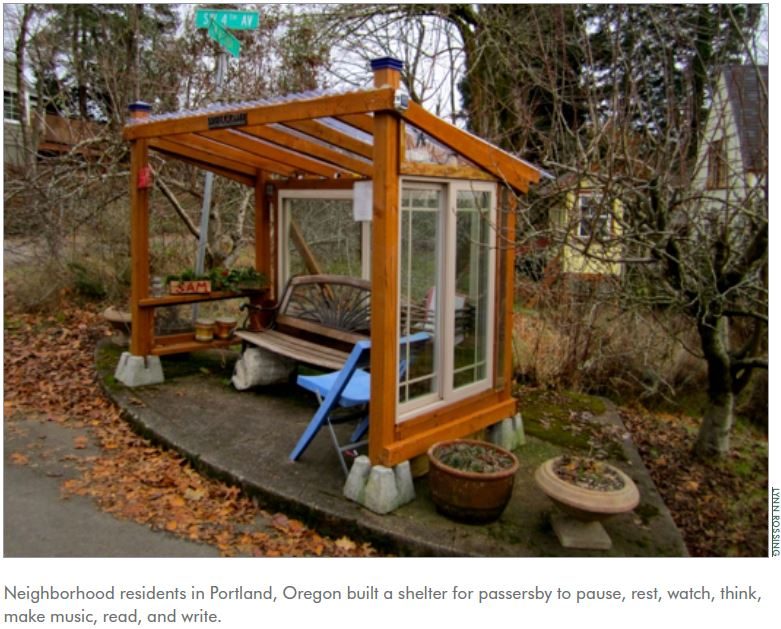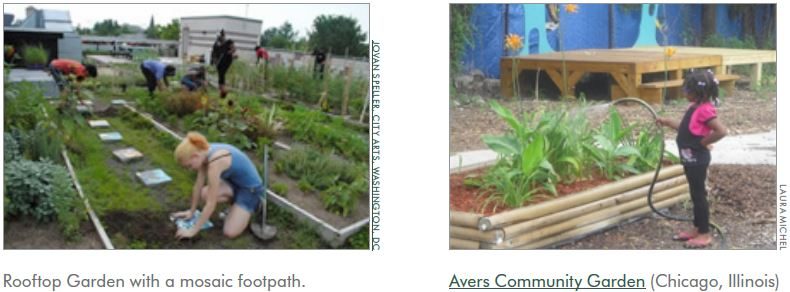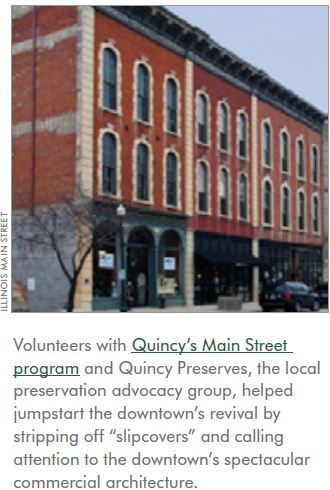Every community has a variety of public spaces, some of which are noticeable and others which may be hidden. Public places most recognized are parks, streets, boulevards, and plazas. But public spaces are also found in between private spaces such as alleys, neglected courtyards, and stairways. These could be a city’s most underutilized and potentially valuable assets.
However, even noticeable public spaces in communities may be unused or underused because of safety concerns or because they have deteriorated — all of which can be improved to increase their usage and usefulness and to strengthen and enrich a community.
Placemaking can enhance a public space and make it come to life. You can help by identifying a public place and developing its positive potential so that whole community can benefit.
Community Gardens
Community gardens have the potential to beautify vacant lots, augment local food supplies and enhance the urban environment in a variety of ways. In addition to increasing the availability of fresh, healthy produce in city neighborhoods, community gardens also provide space for healthy recreation and community connections between citizens.
Added benefits of community gardens include increasing a sense of community ownership and pride, teaching young people where food comes from, and bringing together multiple generations.
Community gardens are a great project in which to involve neighborhood residents and organizations. There are roles for everyone. Residents, students and volunteers can help clear the space of litter, paint colorful signs, install planters and plant the seeds. Funds will be needed for supplies such as fencing, seeds, and lumber to construct raised beds.
Can you think of any neglected, vacant spaces in your community that could become a community garden? This might be a great community outreach project for your members.
Build a Better Block
One way to initiate Placemaking could be with a Better Block project, which is a tool where communities engage in a temporary, short-term (usually 1–2 days) build-out process to show the potential of a one to two block area in need of revitalization.
A Better Block project’s focus is to bring back a neighborhood rapidly rather than developing a larger scale, more financially complex project that could take years. It can help people come together to create a community destination quickly.
Ideas for a Better Block project could include creating pop-up businesses, installing seating areas and planters, inviting local musicians to play and artists to paint, temporarily changing traffic patterns and parking, and making the block more people- and bike-friendly.
You may also want to consider planning and organizing a tour of the vacant buildings. Deb Brown, Director of the Webster City, Iowa, Chamber of Commerce, looked at the empty store fronts downtown and other available buildings around town as opportunities. She and her team held a Tour of Empty Buildings. They worked with local real estate professionals as point people on the tour to field questions about what businesses could be a good fit, square footage, cost, condition and so on. Deb notes that it is important to build relationships with members in your community and ask for their help. They may be able to be part of the tour and provide details about the history of the buildings.
Better Block started over a weekend in April 2010, when a few friends gathered to demonstrate what a revitalized commercial area would look like in Dallas, Texas. The group brought together resources from the community and converted the block into a walkable, bikeable neighborhood destination for people of all ages.
This initial project was developed to show the city how the block could be revived and improved if ordinances that restricted small business and multi-modal infrastructure were removed. Since that time, Better Block projects have been developed throughout the nation with many of the temporary infrastructure improvements and businesses made permanent.
If your Association implements a Better Block project, you may then want to advocate for zoning that would enable the temporary vision to become permanent. NAR’s Land Use Initiative can provide an analysis of a pending local land-use regulation or ordinance, as well as help craft your association’s response to a proposed local ordinance to support your efforts.
Here are some examples of Better Block projects:
Matchmaking between entrepreneurs, developers, potential gallery curators, real estate professionals, and the representatives of vacant properties happens in Better Block Projects. According to Andrew Howard of Team Better Block, real estate professionals associated with projects in Dallas, San Antonio, Fort Worth, Memphis, Norfolk, and elsewhere reported sales of long vacant buildings and/or new leases after a Build a Better Block initiative.
The Better Block approach is gaining traction as a best practice for increasing community consensus on zoning changes, economic incentives and infrastructure projects. The Better Block website provides help for communities who wish to build their own Better Blocks, complete with news, tools, and other resources needed to help rapidly revitalize neighborhoods. Team Better Block provides consulting services, including workshop trainings and creation of a real time experience of a revitalized street.
Is there a block(s) in your community that is run-down, gets little or no foot traffic and where buildings are not leased? You may want to work with partners in your community to plan a Build a Better Block project.
Lighter, Quicker, Cheaper
Lighter Quicker Cheaper (LQC) is a concept developed by the Project for Public Spaces (PPS). It is a “do-it-yourself approach based on taking incremental steps, trying low-cost experiments, and tapping into local talents (e .g. citizens, entrepreneurs, developers, and city staff) to quickly translate a community’s vision into reality and build momentum for further improvements.”
Marisa Novara, Program Director for the Metropolitan Planning Council in Chicago, sees LQC as one way of dealing with the realities of vacant lots and open storefronts.
LQC may consist of several small projects in a neighborhood where, taken together, they will make the neighborhood a better place to live, work and play.
These hands-on projects can be proposed and finished in months or even weeks. They are low-cost and provide a tangible, beautiful benefit to the community.
Some examples of Lighter Quicker Cheaper projects include a community paint day, walking tour/maps, murals, seating, pedestrian havens, public art, butterfly or community gardens, bus shelters, parklets, banners, and a community toolshed. Challenge your members to come up with even more ideas.
Another use of the LQC concept is to transform transitional spaces waiting for development into low-cost, temporary uses.
The Metropolitan Planning Council acknowledges that the vacant spaces in Chicago, particularly in neighborhoods that bore the brunt of the recession, will take a while to achieve their ideal use. In the meantime, it has set out to create meaningful places to exist between a vacant space’s current state and its ideal, finished state.
When Denver’s Union Station underwent a long-term redevelopment, the city issued an open call for artists to present ideas for livening up the massive construction fences that surrounded the site. A crew of crocheters called the Ladies Fancywork Society received a small grant to “yarn bomb” the fence, turning it into a faux garden of crocheted flowers, butterflies and ladybugs that became a tourism draw in and of itself.
In Washington, DC, the Office of Planning has developed a Temporary Urbanism Initiative to transform vacant spaces into vibrant destinations and animated showcases through unique uses. The project includes development of art and culture temporiums which transforms vacant storefronts or spaces into unique temporary retail shops for local entrepreneurs to exhibit and sell their work.
Is there a site under construction in your community? Is the area around your office in need of some tender loving care? You may want to implement a Lighter Quicker Cheaper project to spiff up the space and turn an eyesore into a place that is attractive and welcoming.
Streets and Transit
Many communities are looking at creating transportation systems that enhance places. Rather than just designing roads to accommodate motor vehicles, Placemaking aims to balance all the users of a street — pedestrians, transit riders, motorists and bicyclists. Transit facilities, from a bus stop to a train station, and transportation corridors, from a main street to a boulevard, can function as focal points for shopping, community, economic and social activities. Planning should address how these facilities connect to the surrounding districts and public spaces and make these areas more economically stable, safe and productive.
The Los Angeles County Department of Public Health created Streets for People(S4P) to transform rights of way such as traffic islands and other underused spots into attractive public spaces. Using design elements such as rows of planters and bistro tables and chairs, they are using this as a model to create green spaces around Los Angeles.
San Francisco’s Pavement to Parks Program facilitates the conversion of utilitarian and often underused spaces in the street into publicly accessible open spaces available for all to enjoy. The program includes the Parklet Program designed to create parklets which repurpose part of a street into a public space for people. Parklets provide amenities like seating, plantings, bike parking, and art.
Bus stops are places that can be enhanced and made more welcoming and comfortable by developing a bus stop area plan, which can include adding bus shelters with benches, planting trees, installing/enhancing street lights, hanging banners, installing kiosks, and redesigning streets to be more pedestrian- friendly. Revitalizing adjacent vacant lots by transforming them into parks and community gathering spots improves the value of the bus stops as places.
Many main thoroughfares in a community could be turned into pedestrian-friendly places by increasing the width of sidewalks, enabling parking on both sides of the street, emphasizing bike lanes, installing decorative light fixtures, planters, paver-block sidewalks and crosswalks, benches, trash containers and other amenities.
Traffic Calming
Traffic calming measures are design and management strategies to balance street traffic with other uses to help create and preserve a sense of place so that people can safely walk, stroll, meet, play, and shop along and near streets.
While we typically associate traffic calming with speed humps or curb extensions that narrow a roadway, creative use of paint or decorative plantings can also make streets safer, as well as enhancing the street space and make it appealing.
These projects can help to reduce speeding along residential streets and help remind people they are in a neighborhood full of people — playing children, pets, dog-walkers, bicyclists, and individuals. Street paintings and other unusual visuals and activities — painting on the street, boulevard gardens, sidewalk chalking designs — can create cues that tell drivers to slow down and drive more attentively.
Where is the most unwelcoming bus stop(s) in your community? Wouldn’t it be great to transform that stop into a welcoming, fun, inviting place to wait for a bus?
Creative Placemaking
Communities across our nation are leveraging the arts and engaging design to make their communities more livable with enhanced quality of life, increased creative activity, a distinct sense of place, and vibrant local economies that together capitalize on their existing assets.
Artscape DIY identifies several components to creative Placemaking including cultural districts, creative and cultural industry clusters, mixed-use development, and public and community arts.
Many communities are integrating arts and cultural projects into larger Placemaking initiatives. Public art, which is one component of creative Placemaking, includes works such as large-scale sculptures, projections, mosaics, fountains, monuments, light installations or murals, which are displayed in the public realm to be enjoyed by all. Public art projects are a simple way to get started with creative Placemaking in your community.
Do you know of any local arts organizations that you can partner with to plan a project to create better places by installing works of art, or to work with local residents on a creative Placemaking activity?
Main Street
The National Trust for Historic Preservation (NTHP)has developed Main Street®, an approach to revitalizing traditional commercial districts in a community. A Main Street approach can be considered Placemaking as the end result will enable people to come together to live, work and play in their community.
NTHP believes a city or town’s “main street” is the core of a community. They define Main Street® as three things: a proven strategy for revitalization, a powerful network of linked communities, and a national support program that leads the field. The Main Street Four-Point Approach® is defined by NTHP as a unique preservation-based economic development tool that enables communities to revitalize downtown and neighborhood business districts by leveraging local assets — from historic, cultural, and architectural resources to local enterprises and community pride.
Most states have their own Main Street programs and provide local Main Street organizations with training, tools, information, and networking. Some states, in turn, have regional and local Main Street programs. See a list of Main Street programs in the U.S.
A Main Street program will be more comprehensive than the other Placemaking projects mentioned above and, accordingly, will require more resources and support to plan and manage. The NTHP provides recommendations, such as forming a working group and analyzing your commercial district, to generate the local support necessary to establish a Main Street revitalization initiative.
Is there a town in your area that could benefit from analysis and revitalization of its main street? If so, you may want to follow in the footsteps of the Medina County Board of REALTORS®.





















